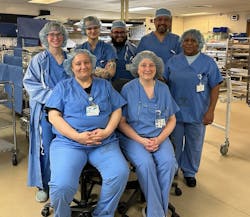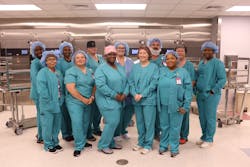Meaningful Partnerships Drive Reprocessing Workflow Improvements
According to Merriam Webster, perioperative is defined as “the period around the time of a surgical operation.” When the topic of perioperative processes arises, most think of the core operating room (OR) team prepping for a case, performing it, and managing the patient post-operatively.
But as anyone involved in these processes will tell you, there are many other stakeholders who play a role in a successful patient procedure, including sterile processing (SP) and infection prevention (IP), supply chain (SC), environmental services (EVS), etc. The work of all these teams – OR, SP, IP, SC, EVS – impact one another. Nobody functions in a silo.
Instrument reprocessing is one area where coordination of efforts among the SP, OR and IP teams can make or break the process. When these parties successfully collaborate for the benefit of their patients, they can significantly improve reprocessing workflow efficiency, effectiveness, and safety.
SP leaders from two U.S. hospitals shared their stories of reprocessing workflow improvements driven by multidisciplinary collaboration: Toni Amorine, Central Sterile Manager for Geisinger Community Medical Center (CMC) in Scranton, Pa., and Michelle Milner, Director of Sterile Processing and Equipment Processing for St. Tammany Health System in Covington, La.
Building upon a foundation of success
Geisinger CMC is a 275-bed hospital with 14 operating rooms. Its Central Sterile department reprocesses an estimated 54,000 instrument sets and 25,000 peel packs and supports nearly 9,000 surgical procedures annually.
CMC’s reprocessing workflow improvements have been driven by meaningful collaboration between the Central Sterile and OR teams.
It began when the teams launched an instrument utilization project where they assessed instruments used in a major laparoscopy tray to reduce the number of times they were reprocessed. This increased instrument longevity, reduced unnecessary repair costs, and made the tray more frequently available for cases.
It also established a meaningful connection that paved the way for the OR team to help the Central Sterile team when they needed it the most. “This project built a stronger bond between OR leadership and CSR leadership which exemplified the relationship we all wished to see from everyone in both departments,” said CMC Central Sterile Manager Toni Amorine.
Stepping up to help with staffing
When the CMC Central Sterile department lost 14 trained technicians and two members of their leadership team, the remaining team members struggled to keep up with the volume of instruments needing to be reprocessed. According to Amorine, there were case carts filling decontamination and spilling out into the hall, plus hundreds of trays unassembled in the prep and pack area.
The CMC OR clinical leader noticed the challenges and began sending scrub techs and nurses to the Central Sterile department to help assemble the trays when they were not assigned to rooms.
“These scrubs and nurses came down day after day to help assemble all the trays that sat building up as we did not have enough staff to stay on top of the workload,” Amorine explained. “This was in part due to the interactions and comradery built by jointly working on the instrument utilization project.”
Addressing implant inventory
In 2022, the CMC Central Sterile and OR teams furthered their collaboration and mutually beneficial work by implementing a cloud-based clinical inventory management system to manage one of their vendor’s implant stock. Each day, the Central Sterile team lead technician or department manager scans packaging from this specific vendor’s implants used by the OR the previous day and then order replacements from the PAR set in the inventory management system.
“This system is far easier than other systems we have used in the past as you scan inventory when it arrives and scan it out when it is used,” said Amorine. “There is an automated order for anything that falls below PAR. The user can click off what they want to reorder from the auto-generated list. At the end of 2022, we had our first inventory since implementing this system and we posted less than a 1% variance!”
A new start for SP
St. Tammany Parish Hospital, part of St. Tammany Health System (STHS), is a 220-bed acute care facility with 12 surgical suites in the main OR, four procedure rooms in Cath Lab, three procedure rooms in Endoscopy, two ORs in Labor and Delivery, and a 43-bay emergency department (ED). The SP team, comprised of 12 full-time processing staff, two liaisons, and four per diem staff, supports patient care areas with 24/7 coverage.
After working in the St. Tammany Parish Hospital SP department for 13 years, Michelle Milner, AAMI Standards Work Group 40 member and American Mensa member, became an SP travel professional learning best practices from SP teams across the U.S. In 2020, she decided to take her learnings back to STHS, becoming the St. Tammany Parish Hospital Director of Sterile Processing and Equipment Processing.
Staffing success
Like most SP departments, St. Tammany Parish Hospital was struggling to find qualified candidates to fill vacancies. This prompted them to collaborate with the AVP of Surgical Services, the AVP of Workforce Strategy, and many others across the system to develop and launch a 16-week, in-house, paid apprenticeship program. Program participants commit to earning their certification within 12 months and work for the department for two years.
Milner commented on her efforts to retain qualified SP technicians, stating:
“I allow my staff to do self-scheduling. I present the shifts I need covered and staff members sign up for the shifts that work for them. For this approach to work I’ve had to get creative. We historically had 7 a.m. – 3 p.m. and 3 pm. – 11 p.m. shifts. Several people were interested in working three 12-hour shifts but that would mean we’d lose 4 hours of worked hours per person in what would be a 40-hour work week. By restructuring to offer some 13-hour shifts, I give them what they need to work only three days a week, but it keeps them whole as a 1.0 FTE, which is what we need as a department.”
Alleviating BI latency
Having addressed staffing issues, they turned their sights on improving reprocessing throughput and efficiency. One of the SP department’s first steps was to switch from biological indicators with an incubation time of 60 minutes to 20-minute biologicals. This allows instrument trays, including implants, to be released from the SP department 66% sooner, which has had a positive impact on procedure start times and OR turnaround times.
Instrument-to-set matching
Another issue impacting reprocessing workflow efficiency was OR scrub techs placing sets in incorrect trays post procedure, which led to confusion in the SP department and subsequently instruments missing from sets.
To address this challenge, the SP team used matching-colored tags to identify trays and instruments used in the same procedure. For example, all instruments for Dr. X’s procedure in OR room #2 at 10 a.m. were identified with a pink tag. This helped them find instruments “missing” from sets that were placed in the incorrect trays, increasing the number of complete trays being released by 53%. This in turn decreased the need for OR and SP staff to search for peel packs to complete trays when picking case carts.
Tray accuracy improvements
Next, they formed a multi-disciplinary team, mainly comprised of SP, OR and IP staff members, to launch a Process Improvement (PI) initiative focused on tray accuracy with surgical instrument tracking software supporting their efforts. Baseline data showed that only 91.89% of the trays sent to the OR were deemed accurate, so the PI team set an aggressive accuracy goal with an upper limit of 95% with a lower limit of 93%.
They acknowledged how the OR and SP teams’ work impacts each other, the need for all parties to follow standard procedure, and how compliance failures add work and decrease efficiency across the board. For example, when OR technicians send instruments to decontamination in the wrong trays, it increases work for SP technicians and can lead to longer reprocessing turnaround times.
The ability to track a tray back to the OR room in which it was used enables the OR and SP teams to identify when OR technicians have put instruments into the wrong trays and provide re-education to improve compliance with procedure moving forward.
In turn, they also identify which SP technicians are assembling incomplete or inaccurate trays or trays with broken instrumentation, which leads to OR and SP teams scrambling to address these issues when these trays arrive in the OR for a procedure.
“The OR audits the completeness and accuracy of our trays and submits the audit results with their case carts post-procedure,” Milner explained. "I can discuss tray errors with the SP technician. Getting the info in real time on issues with their trays allows me to provide re-education or counseling to prevent them from happening again. As with the OR technicians, it’s often a case where the individual requires re-education, especially with new staff members joining the department.”
“Within three months, we attained our goal within the target range, so we then increased our target accuracy rate to 98% as the upper limit and 95% as the lower limit,” Milner continued. “To date, we have maintained the 98% accuracy rate with both experienced staff and the newly promoted specialists from the apprentice programs.”
Planning reprocessing improvements in 2024? Consider these 3 factors
By Kara Nadeau
Staffing shortages, changing compliance and guidelines, greater device complexity, higher surgical volumes – these are some of the key challenges facing sterile processing (SP) professionals according to the Pure Processing 2023 SPD State of the Industry Report – and there are no signs they are letting up in the new year.1
The company’s Clinical Education Specialist, Hannah Schroeder CRCST, CIS, CHL, CER, offered SP leaders these three factors to consider when planning reprocessing improvements to address these issues in 2024 and beyond.
- Change management: “Every facility needs to have a solid change management plan in place; their go-to structure or program they use to implement changes. It could be as simple as identifying the issue, evaluating current practice, and running audits on gaps in that practice to set goals to close those gaps. Education and training are also incredibly important to helping staff members feel confident in the change.”
- SP team buy-in: “Leverage your teams’ experience and listen to their challenges to assist with shaping your plan. Keep this collaboration going as the change takes place. Leaders should work side-by-side with their teams to overcome hurdles and celebrate successes. Employees appreciate knowing their leaders are down in the trenches with them, supporting and advocating for positive changes.”
- Time to adjust: “One of the biggest returns on investment (ROI) I’ve had when implementing change is a grace period. After implementing a change, allow your team a set period to make mistakes, ask questions and adjust to the new practice or process without the pressure to perform efficiently right out of the gate. We provide training and progress steps for our new hires, and the same should be provided during process changes. Depending on the scope of the change and the number of staff members involved, this period could last from a week to a month. In doing so, you acknowledge the learning curve and your desire as a leader to help them succeed.”
Referemce:
1. Pure Processing 2023 SPD State of the Industry Report, November 13, 2023, https://pure-processing.com/blog/the-future-challenges-in-spd-identified-trends-from-the-2023-spd-state-of-the-industry-report/
Reprocessing pressures rise in 2024 with move toward more reusable items
By Kara Nadeau
U.S. hospitals generate significant waste - more than 5 million tons of it annually.1 Reliance on single-use disposable items contributes to this waste, with the Agency for Healthcare Research and Quality (AHRQ) urging healthcare organizations to “expand reusable inventories to maximize material value and minimize pollution.”2
Additionally, on January 1, 2024, The Joint Commission’s (TJC) voluntary Sustainable Healthcare Certification (SHC) program became effective, under which participating healthcare organizations are evaluated on their efforts to improve “energy efficiency, decrease their carbon footprint, and decrease waste.”3
“Device reuse is being discussed more and more in healthcare,” said Lars Thording, VP of Marketing and Public Affairs at Innovative Health. “I’m trying to be a voice in that because there’s growing recognition that both financial and environmental waste increases when the single use mindset wins. On the other hand, when new reuse policies and practices are introduced into healthcare, hospitals win.”
With regards to the challenges that come with reusable items, Thording pointed to the current hospital sterile processing (SP) environment, which “is one of great staffing resource and budget constraints.” With many SP teams struggling to reprocess the high volumes of reusable instruments and devices already coming into their departments, effectively and safely transitioning from more single use to reusable items isn’t always feasible.
“The processes SP teams undertake are extremely critical both from an operational and financial perspective,” Thording explained. “If you don’t treat a reusable product right as it travels to SP, is reprocessed, and sent back to the operating room (OR), then it won’t work. The OR team is losing valuable and costly time as they wait for a replacement product, and in an extreme scenario, the patient is lying there on the table. Then there is the cost to buy a replacement device.”
The other challenge is while more single use items are coming to market that can technically and legally be reprocessed, hospitals lack not only the SP resources to reprocess them but also the U.S. Food & Drug Administration (FDA) clearance to perform this task.
Given these realities, Thording believes outsourced single use device reprocessing to an FDA cleared reprocessor is “one of the most impactful device reuse solutions we have in healthcare today.” He pointed to his company’s success reprocessing complex single use mapping catheters, diagnostic catheters, and other electrophysiology devices.
“It is a proven way to reduce costs, lessen environmental impact and is becoming a bit of a template for how other reuse situations can be implemented in healthcare,” Thording concluded.
References:
1. Waste, Practice Greenhealth, https://practicegreenhealth.org/topics/waste/waste-0
2. Reducing healthcare carbon emissions, AHRQ, September 2022, https://www.ahrq.gov/sites/default/files/wysiwyg/healthsystemsresearch/decarbonization/decarbonization.pdf
3. Sustainable Healthcare Certification, The Joint Commission (TJC), https://www.jointcommission.org/standards/prepublication-standards/sustainable-healthcare-certification-program/

Kara Nadeau | Senior Contributing Editor
Kara Nadeau is Sterile Processing Editor for Healthcare Purchasing News.








